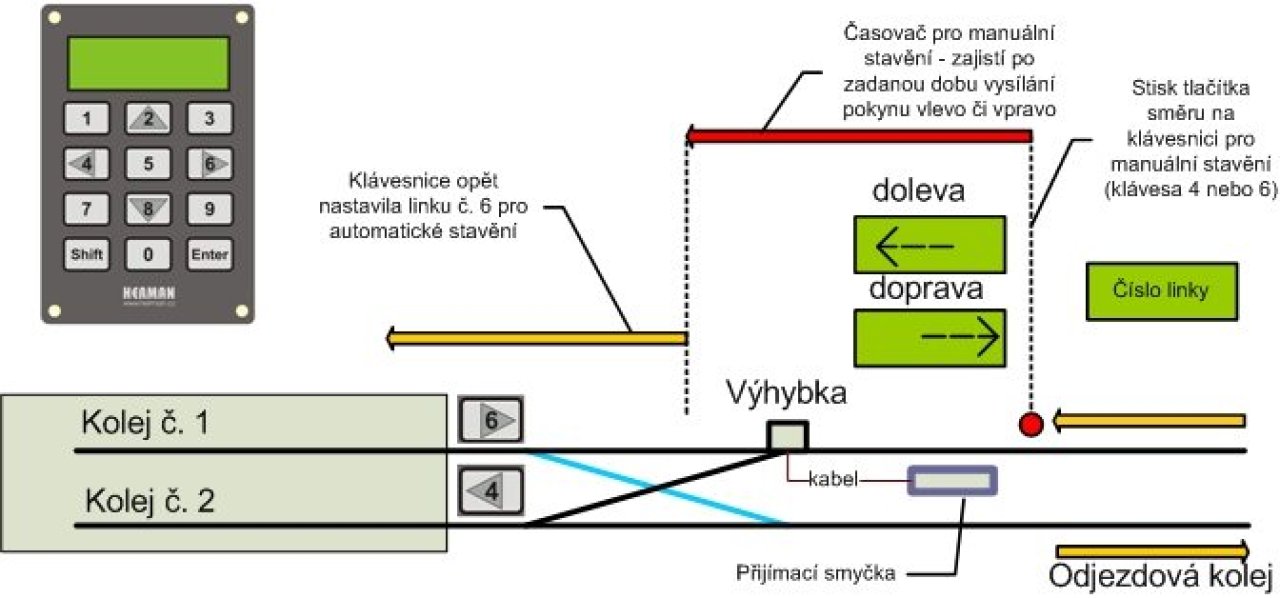Keyboard for BSV
The principle of automatic building using the keyboard unit:
At the final station, the driver enters the line and the destination to the next station. This line and destination is transmitted while the vehicle is moving and all intelligence is concentrated in the turnout, which rebuilds the turnout based on this data. It then simply enters a "ride back" command at the next terminus and does not need to enter the full data. For systems with two-way communication, it is possible to send the 'reverse' command automatically from the turnout system to the end station. The driver then does not need to 'touch' the system. If no data is entered, the destination station 0000 is transmitted, to which the points must not react, but only lock.
The SHIFT key is used to enter the destination code editing mode. When it is pressed, the past destination code is displayed and the display flashes. This can either be overwritten with a new target code or confirmed by pressing ENTER. If the ENTER key is pressed, the displayed data becomes the valid current destination code (i.e. "driving back"). If the 0 - 9 key is pressed, a new destination code is entered - the first three positions of the display show zeros on the left, the digits of the pressed key on the right. The next pressed digits are filled in from the right. The entered destination code is confirmed with the ENTER key. If the SHIFT key is pressed again in the target code entry mode, the target code entry mode is restarted - the previous target code is displayed again, which can be overwritten or confirmed. If the key is not pressed for 10 s in the target code entry mode, the KB 10 keypad unit enters normal operating mode, where the current transmitted target code is displayed, alternating with an error message if necessary.
Prin cip manual build from the keypad unit:
cip manual build from the keypad unit:
The keypad has arrows marked on keys 2,4,6 and 8. If the driver presses the appropriate key (2,4 or 6) during normal operation, the system will start transmitting the code for that key for a preset period of time (e.g. 1 minute). After this time has elapsed, the system reverts back to automatic status.
This situation is indicated in the following figure, where the tram driver arrives at the terminus and has to choose which track to take. He then presses the appropriate button and the symbol for the command appears on the keypad display (the arrow consists of the three displays - see figure). During the time the positioning symbol is lit, the manual positioning code is transmitted and the driver does not have to concentrate on the exact position of the receiving coil. After the set time has elapsed in the unit's configuration, the system reverts to automatic positioning.
Indication of error and internal conditions of the transmitting system, system settings
The keypad unit indicates its own (internal) errors as well as errors of the BSV-TR 10, BSV-TR 12 and other transmitting vehicle units. At the same time, the keypad can be used to read out and set the parameters of the transmitting unit (e.g. output transmit power). If an internal unit error KB 0x is detected, this error code is displayed in priority. A possible error of the transmitting vehicle unit is only displayed if there is no internal error BSV-KB 0x. If no error is detected for either unit, the error code is not displayed at all - i.e. the current target code is permanently lit.
The meaning of the internal error code bits is as follows:
- 0. transmitting modem error bit
- 1. bit digital potentiometer error
- 2. bit transmit coil error 1
- 3. bit transmit coil error 2
- 4. bit keyboard communication error
- 5. - 6. bit reserve
